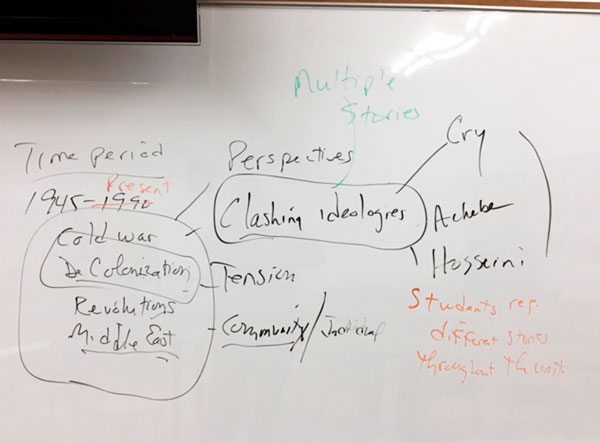Considering Eastern Christian School? Join us at an upcoming open house event or take a personal tour! Register Online
Oh, the Humanities! (And a Banana and Orange Juice)
- Why is the year the Beatles released their hit single, “Love Me Do” significant?
- Which picture book do you remember loving first as a child?
- How do the patterns of designer William Morris make you feel?
- Do the poems of Rumi and Rupi Kaur have anything in common?
Music. Art. Philosophy. Literature. History. Like some of us, maybe you swoon at the sight of such beautiful words. I must confess: I do. (I do, take Thee, humanities, to be my lawfully wedded life!)
To the questions above, examples of topics we might study in one of our 4 humanities courses at ECHS, we might add anything related to Radiohead, the 2016 Presidential Election, John Singer Sargent, post-modernism, Alexander Hamilton, the Middle East, bebop. We might add soul food, John Milton, Les Mis, Gregorian chant, Donald Duck.
Our humanities program is taught by history and English teachers committed to exploring human culture in historical context. And, while the program has been around for some significant years (perhaps you were a humanities student yourself once, a long time ago?), the department teachers are beginning to journey into some exciting development in our courses!
An Odyssey of our Very Own
With a recent focus, through curriculum work and our Middle States Accreditation process, on the global competence of our students, we’re set on expanding the width of our cultural view in the humanities program. We’re committed to developing a graduate who “embraces diversity, exhibits compassion, offers respect, and is forgiving and open to others” (ECS Graduate Profile). And to do so, we’re aiming at developing diverse curricular experiences for our students.
In October, the humanities teachers sat down together to begin the journey of looking at our curriculum and pointing out our team’s strengths and weaknesses. Over the next few months, we reflected on, shared, and talked through why we think some of our less successful units are not as great as the ones we see leading to better student learning. What we’ve found is that the best units are those in which all the parts blend together like the perfect berry fusion of a good smoothie. Units where the history, arts, and literature are all singing the sweet three-part harmony that lifts our kids off their seats into the air like street dancers in an orange juice commercial. (Don’t tell me you haven’t seen that ad. And, yes, we might study that commercial in humanities, too.)
Then, last week, a very brave pair of teachers offered their most frustrating unit up for our first “Humanities Intervention Rehabilitation” project. Together, our team of teachers deconstructed the unit, peeling it back to the bare bones (or banana, if you’re still stuck on my smoothie reference earlier), and recentered the curricular focus. What do we want students to walk away with? Which concept will actually connect to their lives in a meaningful way?
Since we’re teachers, we can’t help but do our brainstorming with the always effective whiteboard. Our strategizing looked a little like this: (Actually, it looked exactly like this.)
Why This Works
Our few hours together in “rehabbing” one of our course units as a team is a great example of the best kind of curriculum work: work that happens with teachers who are connected to the content and students they teach and that’s accomplished by a group of professionals who each bring their individual strengths and perspectives to the process. It’s the kind of work I personally love best. It’s inspiring, encouraging, builds ideas in community, and invites the kind of deep thinking that good lesson and unit planning thrives from. It’s fun. And I always learn things while we do it.
This unit, as you can see in the photo above, is on its way to pushing right into the present day, inviting students to study the very culture they swim in every day. It’s opening up to the potential to include Middle Eastern, African, and Asian literature, even contemporary pieces. And it’s realigning the ways we study the Cold War, decolonization, and the Middle East. After a couple hours in the Humanities Hospital, I’d say this unit is going to pull through just fine.
The Future’s Looking Bright
The traditional school structure has a tendency to teach, unintentionally, an isolated view of life. You go to that room so that teacher can teach you how to use numbers. But you go to that room where that teacher will teach you how to use chemicals. That one will help you paint. That one will help you speak Spanish. Teachers, too, can feel the isolation when they close the door behind them and stand alone as the kings in their own little classrooms.
Our humanities program is so exciting because it takes us out of isolation and lands us back where we belong, in community and connection. And it’s even more exciting to develop and redevelop our coursework in the same way, as a community of educators come together to explore new and unique ways of expanding the horizons of the cultures we study.
Next up for this team of surgeons at the Humanities Hospital? A medieval ages unit that has the potential to cover thousands of years in just one delicious bite. Bon Appetite!





